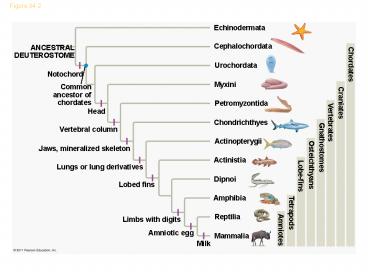Nerve activates contraction - PowerPoint PPT Presentation
1 / 39
Title:
Nerve activates contraction
Description:
Figure 34.2 Echinodermata Cephalochordata ANCESTRAL DEUTEROSTOME Chordates Urochordata Notochord Myxini Craniates Common ancestor of chordates Petromyzontida – PowerPoint PPT presentation
Number of Views:128
Avg rating:3.0/5.0
Title: Nerve activates contraction
1
Figure 34.2
Echinodermata
Cephalochordata
ANCESTRALDEUTEROSTOME
Chordates
Urochordata
Notochord
Myxini
Commonancestor ofchordates
Craniates
Petromyzontida
Head
Vertebrates
Chondrichthyes
Vertebral column
Actinopterygii
Gnathostomes
Jaws, mineralized skeleton
Actinistia
Osteichthyans
Lungs or lung derivatives
Lobe-fins
Dipnoi
Lobed fins
Amphibia
Tetrapods
Reptilia
Limbs with digits
Amniotes
Amniotic egg
Mammalia
Milk
2
Figure 34.2a
Echinodermata
Cephalochordata
ANCESTRALDEUTEROSTOME
Urochordata
Notochord
Myxini
Commonancestor ofchordates
Petromyzontida
Head
Chondrichthyes
Vertebral column
Jaws, mineralized skeleton
Osteichthyes
3
Figure 34.2b
Actinopterygii
Actinistia
Lungs or lung derivatives
Dipnoi
Lobed fins
Amphibia
Reptilia
Limbs with digits
Amniotic egg
Mammalia
Milk
4
Chordate characteristics
5
Subphylum Urochordata a tunicate
6
Subphylum Cephalochordata lancelet anatomy
7
Subphylum Cephalochordata the lancelet
Branchiostoma
8
The neural crest, embryonic source of many unique
vertebrate characters
9
Figure 34.2
Echinodermata
Cephalochordata
ANCESTRALDEUTEROSTOME
Chordates
Urochordata
Notochord
Myxini
Commonancestor ofchordates
Craniates
Petromyzontida
Head
Vertebrates
Chondrichthyes
Vertebral column
Actinopterygii
Gnathostomes
Jaws, mineralized skeleton
Actinistia
Osteichthyans
Lungs or lung derivatives
Lobe-fins
Dipnoi
Lobed fins
Amphibia
Tetrapods
Reptilia
Limbs with digits
Amniotes
Amniotic egg
Mammalia
Milk
10
A hagfish
11
A sea lamprey
12
Hypothesis for the evolution of vertebrate jaws
13
Cartilaginous fishes (class Chondrichthyes)
Great white shark (top left), silky shark (top
right), southern stingray (bottom left), blue
spotted stingray (bottom right)
14
Anatomy of a trout, a representative ray-finned
fish
15
A coelocanth (Latimeria), the only extant
lobe-finned genus
16
Figure 34.2b
Actinopterygii
Actinistia
Lungs or lung derivatives
Dipnoi
Lobed fins
Amphibia
Reptilia
Limbs with digits
Amniotic egg
Mammalia
Milk
17
Figure 34.21
Lungfishes
Eusthenopteron
Panderichthys
Tiktaalik
Acanthostega
Tulerpeton
Limbswith digits
Amphibians
Key tolimb bones
Ulna
Radius
Amniotes
Humerus
Silurian
PALEOZOIC
Carboniferous
Permian
Devonian
415
400
385
370
355
340
325
310
295
280
265
0
Time (millions of years ago)
18
Figure 34.17x1 Frogs
19
(No Transcript)
20
(No Transcript)
21
Figure 34.25
Parareptiles
Turtles
Crocodilians
Reptiles
Pterosaurs
Archosaurs
Ornithischiandinosaurs
Dinosaurs
Saurischian dinosaursother than birds
Diapsids
Saurischians
Birds
Plesiosaurs
ANCESTRALAMNIOTE
Ichthyosaurs
Tuataras
Lepidosaurs
Squamates
Mammals
Synapsids
22
Amniotic egg
23
Extant reptiles Desert tortoise (top left),
lizard (top right), king snake (bottom left),
alligators (bottom right)
24
(No Transcript)
25
Form fits function the avian wind and feather
26
Archaeopteryx, a Jurassic bird-reptile
27
A small sample of birds Blue-footed boobies (top
left), male peacock (top right), penguins (bottom
left), perching bird (bottom right)
28
Figure 34.30 Evolution of the mammalian jaw and
ear bones
29
(No Transcript)
30
Australian monotremes and marsupials echidna
(top left), marsupial mouse (lower left), sugar
glider (right)
31
Figure 34.41a
Monotremes(5 species)
Monotremata
Marsupialia
Marsupials(324 species)
ANCESTRALMAMMAL
ProboscideaSireniaTubulidentataHyracoideaAfros
oricidaMacroscelidea
Eutherians(5,010 species)
Xenarthra
RodentiaLagomorphaPrimatesDermopteraScandentia
CarnivoraCetartiodactylaPerissodactylaChiropter
aEulipotyphiaPholidota
32
(No Transcript)
33
Figure 34.43
Lemurs, lorises,and bush babies
Tarsiers
ANCESTRALPRIMATE
New World monkeys
Anthropoids
Old World monkeys
Gibbons
Orangutans
Gorillas
Chimpanzeesand bonobos
Humans
20
10
0
60
50
40
30
Time (millions of years ago)
34
ProsimiansLemurs
35
A capuchin, a New World monkey (left), and a
vervet, an Old World monkey (right)
36
Apes Gibbon (top left), orangutan (top right),
gorilla (bottom left), chimpanzee (bottom right)
37
A timeline for some hominid species
38
Upright posture predates an enlarged brain in
human evolution
39
Figure 34.UN10
Description
Clade
Basal chordates marine suspension feeders
thatexhibit four key derived characters of
chordates
Cephalochordata(lancelets)
Marine suspension feeders larvae display
thederived traits of chordates
Urochordata(tunicates)
Jawless marine organisms have head that
includesa skull and brain, eyes, and other
sensory organs
Myxini(hagfishes andrelatives)
Chordates notochord dorsal, hollownerve cord
pharyngeal slits post-anal tail
Craniates two sets of Hoxgenes, neural crest
Petromyzontida(lampreys)
Jawless vertebrates typically feed by attaching
to alive fish and ingesting its blood
Gnathostomes hinged jaws, four sets of Hox genes
Chondrichthyes(sharks, rays,skates, ratfishes)
Aquatic gnathostomes have cartilaginous
skeleton,a derived trait formed by the reduction
of anancestral mineralized skeleton
Vertebrates Dix genes duplication,backbone of
vertebrae
Aquatic gnathostomes have bony skeleton
andmaneuverable fins supported by rays
Actinopterygii(ray-finned fishes)
Actinistia(coelacanths)
Ancient lineage of aquatic lobe-fins still
survivingin Indian Ocean
Osteichthyans bony skeleton
Dipnoi(lungfishes)
Freshwater lobe-fins with both lungs and gills
sistergroup of tetrapods
Lobe-fins muscular fins or limbs
Amphibia(salamanders,frogs, caecilians)
Have four limbs descended from modified fins
mosthave moist skin that functions in gas
exchange manylive both in water (as larvae) and
on land (as adults)
Tetrapods four limbs, neck, fusedpelvic girdle
Amniotes amniotic egg, rib cage ventilation
Reptilia(tuataras, lizardsand snakes,
turtles,crocodilians, birds)
One of two groups of living amniotes have
amnioticeggs and rib cage ventilation, key
adaptations for lifeon land
Mammalia(monotremes,marsupials,eutherians)
Evolved from synapsid ancestors include
egg-layingmonotremes (echidnas, platypus)
pouched marsupials(such as kangaroos, opossums)
and eutherians(placental mammals, such as
rodents, primates)































